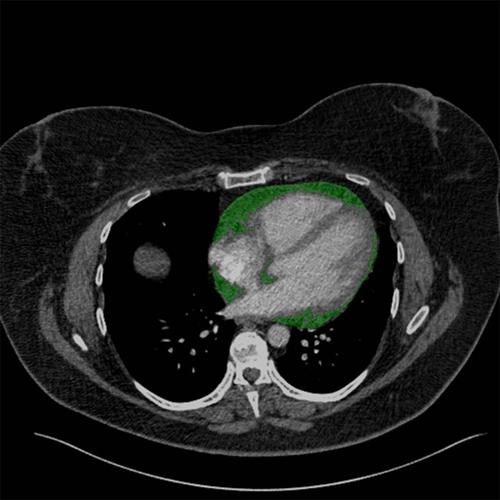Herz ( IF 1.7 ) Pub Date : 2023-10-17 , DOI: 10.1007/s00059-023-05210-5 Anar Aghayev 1 , Mattes Hinnerichs 1 , Andreas Wienke 2 , Hans-Jonas Meyer 3 , Alexey Surov 1, 4

|
Background
Epicardial adipose tissue (EAT) has been established as a quantitative imaging biomarker associated with disease severity in coronary heart disease. Our aim was to use this prognostic marker derived from computed tomography pulmonary angiography (CTPA) for the prediction of mortality and prognosis in patients with acute pulmonary embolism.
Methods
The clinical database was retrospectively screened for patients with acute pulmonary embolism between 2015 and 2021. Overall, 513 patients (216 female, 42.1%) were included in the analysis. The study end-point was 30-day mortality. Epicardial adipose tissue was measured on the diagnostic CTPA in a semiquantitative manner. The volume and density of EAT were measured for every patient.
Results
Overall, 60 patients (10.4%) died within the 30-day observation period. The mean EAT volume was 128.3 ± 65.0 cm3 in survivors and 154.6 ± 84.5 cm3 in nonsurvivors (p = 0.02). The density of EAT was −79.4 ± 8.3 HU in survivors and −76.0 ± 8.4 HU in nonsurvivors (p = 0.86), and EAT density was associated with 30-day mortality (odds ratio [OR] = 1.07; 95% confidence interval [CI]: 1.03; 1.1, p < 0.001) but did not remain statistically significant in multivariable analysis. No association was identified between EAT volume and 30-day mortality (OR = 1.0; 95% CI: 1.0; 1.0, p = 0.48).
Conclusion
There might be an association between EAT density and mortality in patients with acute pulmonary embolism. Further studies are needed to elucidate the prognostic relevance of EAT parameters in patients with acute pulmonary embolism.
中文翻译:

心外膜脂肪组织作为急性肺栓塞的预后标志物
背景
心外膜脂肪组织(EAT)已被确立为与冠心病疾病严重程度相关的定量成像生物标志物。我们的目的是利用这种源自计算机断层扫描肺血管造影(CTPA)的预后标志物来预测急性肺栓塞患者的死亡率和预后。
方法
回顾性筛选2015年至2021年间急性肺栓塞患者的临床数据库。总体而言,分析纳入了513名患者(216名女性,42.1%)。研究终点是 30 天死亡率。在诊断 CTPA 上以半定量方式测量心外膜脂肪组织。测量每位患者的 EAT 体积和密度。
结果
总体而言,60 名患者(10.4%)在 30 天的观察期内死亡。幸存者的平均 EAT 体积为 128.3 ± 65.0 cm 3 ,非幸存者的平均 EAT 体积为 154.6 ± 84.5 cm 3 ( p = 0.02)。幸存者的 EAT 密度为 -79.4 ± 8.3 HU,非幸存者为 -76.0 ± 8.4 HU ( p = 0.86),并且 EAT 密度与 30 天死亡率相关(比值比 [OR] = 1.07;95% 置信区间 [ CI]:1.03;1.1,p < 0.001),但在多变量分析中并未保持统计学显着性。EAT 体积和 30 天死亡率之间没有发现关联(OR = 1.0;95% CI:1.0;1.0,p = 0.48)。
结论
急性肺栓塞患者的 EAT 密度和死亡率之间可能存在关联。需要进一步的研究来阐明 EAT 参数与急性肺栓塞患者的预后相关性。



























 京公网安备 11010802027423号
京公网安备 11010802027423号